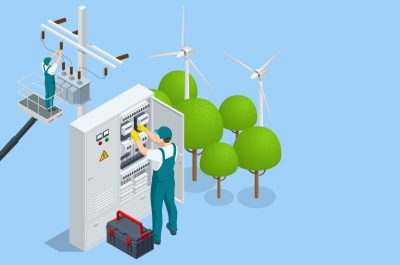Hedging your bets – the new way to drive transmission investment?
The Australian Energy Market Commission (AEMC) is again reviewing the Coordination of Generation and Transmission Investment (COGATI), to look at the drivers that could impact future transmission and generation investment.
The directions paper released in late June as part of this process proposes fundamental reforms to the arrangements by which:
- wholesale market prices are specified – by shifting to locational marginal prices for settling scheduled and semi-scheduled generation and scheduled load (together ‘scheduled energy’);
- generators can manage the risk of constraints on their ability to dispatch energy to the market – by the introduction of financial transmission hedges which provide financially firm access; and
- the Australian Energy Market Operator (AEMO) and transmission network service providers plan the network – through the introduction of a ‘generator access standard’ to which the networks must be planned.

Energy Networks Australia last week provided a response to the directions paper reinforcing networks’ support for reforms to the access regime where they are in the long-term interests of consumers.
Networks are supportive in principle to the first two elements of the AEMC’s proposed reforms. These arrangements have been proven to work internationally but to be confident, further work is required to flesh out the detail and transition arrangements and to ensure implementation timeframes are sufficient.
However, the AEMC’s proposal for transmission hedges to drive network investment has no precedent in other markets. It is not required to realise the benefits from the other two elements of the reforms and it puts at risk the efficient development of the transmission network. It is unworkable and should not be pursued further.

What is a transmission hedge?
A transmission hedge is a financial instrument in which generators can invest to protect themselves from (financial) loss should network constraints prevent them from dispatching into the market. These instruments can help improve investment certainty for generators and may lower the cost of capital.
Transmission hedges to drive network investment has no precedent
The proposal for financial transmission hedges to drive network investment would lead to an obligation on Australian Energy Market Operator (AEMO) and transmission network service providers to plan and build the network to reflect the number of hedges sold. This is an unworkable scenario and, understandably, not a feature of any other electricity market.
Academic research concludes that there are good reasons why an approach where transmission investment driven by the sale of financial transmission rights (FTRs) rather than strategic, integrated planning processes is unworkable[1]. There are no markets where the sale of long-term hedges drives major investment in shared transmission network.[2]
This is somewhat analogous to planning our road network based on commitments from trucking companies and we think this element of the COGATI reforms should not be considered further. Instead, effort should be focused on the implementation of locational marginal prices and transmission hedging to provide generators with a risk management tool. These already represent substantive changes to the current arrangements which can be expected to provide many (if not all) of the benefits sought by the AEMC. They will improve wholesale market efficiency and signals for transmission and generation coordination.
The Integrated System Plan (ISP) and regional planning should remain central to transmission network development
The Integrated System Plan (ISP) and regional planning processes should continue to be the central elements of transmission planning. This coordinated approach ensures customers pay the lowest cost possible for a reliable and secure system as Australia’s generation sector transforms and decarbonises.
Information revealed through locational marginal pricing (in particular price separation between nodes) and through demand for transmission hedges between particular nodes can be one source of data used to help inform network development. This is consistent with the approach adopted in New Zealand. Specifically, such information may have value in the development of the ISP and in regional planning processes. It would help substantiate expectations around network congestion (and therefore the ‘identified need’ for transmission investment) and the weight that should be given to future generation development scenarios. As such, it would be considered alongside other information as part of these planning processes.
Towards post-2025 changes
The COGATI process is progressing alongside the Energy Security Board’s post-2025 review that is considering what the future energy market should look like. It’s essential that these reviews inform each other. It would be a major problem if COGATI recommended changes that were inconsistent with the market design recommended by the ESB.
REZ development should be subject to separate consultation
The AEMC’s directions paper sets out two options for assisting the development of renewable energy zones (REZs) as a transitional measure ahead of the introduction of locational marginal pricing and transmission hedges. The AEMC’s focus is on the following two options to:
- Develop ways to reduce the risk that the renewable energy zones will not be fully utilised; and
- Allow the speculative risks of the renewable energy zone to be shared between multiple parties.
Networks propose that the development of REZ arrangements should be done through a separate consultation process to COGATI. This would allow a range of development options for REZs to be considered, reflective of the fact that REZ development is not a ‘one-size-fits-all’ matter.
The mechanisms considered for REZ development should include:
- the government-supported funding approach being developed by the Energy Security Board;
- the exploration of an ‘open-season’ type process as indicated under the AEMC’s option one; and
- the use of some form of down-payment or transmission bond, so that generators (or other parties) can back their intentions by putting up financial commitments, some portion of which may then be refunded once those generators have connected to the developed REZ.
Although supportive of consideration of flexible funding arrangements, networks have a number of reservations about any model that appears to set up a fundamental disconnect between the party bearing the risk (the transmission network service provider) and the parties who determine the extent of that risk (AEMO) and party assessing the allowed compensation for bearing that risk (the Australian Energy Regulator). This scenario carries the very real risk of investment not proceeding.
At the end of the day, what does it mean for the customer?
The AEMC has a mammoth task ahead of it to deliver a final report to the December 2019 COAG meeting that demonstrates the benefit of reforms to customers in an increasingly complex market. What shouldn’t get lost in the complexity of the task is the objective to ensure customers pay as low a cost as possible for a reliable and secure system as the generation sector transforms and decarbonises. Networks have firm views on the issue and we hope these are reflected in the next round of consultation.
[1] See for example, H Fraser, Can FERC’s standard market design work in large RTOs?, in Electricity Journal, July 2002.
[2] In the US there are a very limited number of cases where radial transmission investment has been funded by the sale of FTRs, but this has been in the context of merchant transmission links, rather than regulated transmission network service providers.



